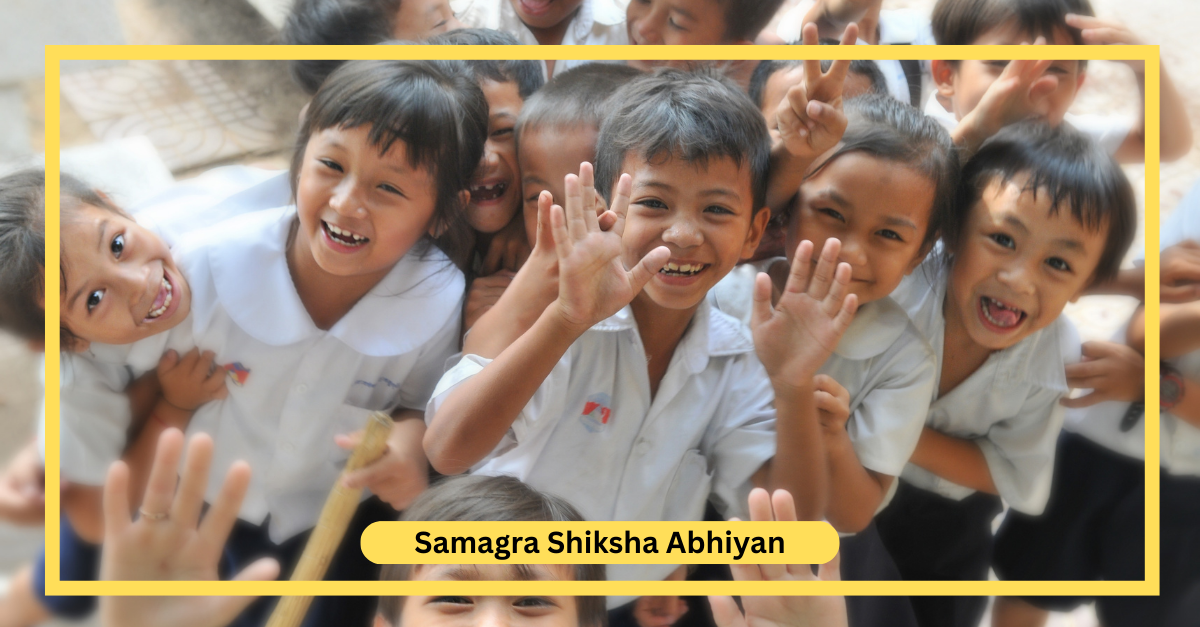Samagra Shiksha Abhiyan focuses on universal equity, and quality improvement, aiming to enhance learning outcomes and prepare students for the challenges of the 21st century.
Overview
Samagra Shiksha Abhiyan, a comprehensive program spanning from pre-school to class 12, designed with the overarching goal of enhancing school effectiveness by ensuring equal opportunities for education and fostering equitable learning outcomes. This initiative consolidates the previously distinct Sarva Shiksha Abhiyan (SSA), Rashtriya Madhyamik Shiksha Abhiyan (RMSA), and Teacher Education (TE) schemes. Beyond amalgamating these programs, Samagra Shiksha seeks to streamline implementation mechanisms and reduce transaction costs across all levels, utilising state, district, and sub-district resources. The program envisions a unified strategic plan for district-level development in school education, emphasising a shift from project-specific objectives to enhancing system-level performance and overall schooling outcomes. Additionally, it incentivises states to focus on improving the quality of education.
Samagra Shiksha Abhiyan – Objectives
Started by the Indian government and is managed by the Department of School Education and Literacy within the Ministry of Human Resource Development. Its goal is to raise the standard of education provided in schools. The following are a few of the scheme’s goals:
- Represents a change in the way that education is designed, seeing ‘school’ as a whole, from preschool to senior secondary levels
- Drafted with the overarching objective of fostering school effectiveness
- Ensuring equal opportunities and equitable learning outcomes
- Under the auspices of Samagra Shiksha Abhiyan (SSA), the Ministry of Education started the NIPUN Bharat Programme in June 2021 to address the educational requirements of children aged three to nine.
Coverage of Samagra Shiksha
Samagra Shiksha Abhiyan spans an expansive reach, covering 1.16 million schools and impacting over 156 million students, alongside the engagement of 5.7 million teachers in both Government and Aided schools.
It covers the educational spectrum from pre-primary to senior secondary levels, the program thrives on inclusive collaboration from all stakeholders within the educational ecosystem. This collective engagement includes teachers, educators, students, parents, community members, school management committees, SCERTs, DIETs, BITEs, Block Resource Persons, Cluster Resource Persons, and dedicated volunteers, all working towards the common goal of delivering education that is of high quality, inclusive, and equitable.
Structured in accordance with the Samagra Shiksha framework, this educational initiative follows a groundbreaking pedagogical and curricular structure, organised in a 5+3+3+4 format:
- Foundational Stage (5 years): Places a strong emphasis on multilevel, play-based, and activity-centric learning, catering to the early years in Anganwadi/pre-school
- Preparatory Stage (3 years): Centred around play, discovery, and interactive classroom learning, this phase focuses on preparing students during their formative years
- Middle Stage (3 years): Incorporating experiential learning, this stage spans various disciplines including sciences, mathematics, arts, social sciences, and humanities
- Secondary Stage (4 years): Aiming for a multidisciplinary approach, this stage fosters greater critical thinking, flexibility, and empowers students by providing the autonomy to choose their subjects.
Samagra Shiksha Abhiyan Genesis
The Samagra Shiksha Abhiyan integrates and enhances school education by consolidating three schemes: Rashtriya Madhyamik Shiksha Abhiyan (RMSA), Sarva Shiksha Abhiyan (SSA), and Teacher Education (TE). Emphasising seamless schooling from preschool to senior secondary levels, it focuses on improving education quality through the synergy of Teachers and Technology.
The Ministry of Human Resource Development oversees the vocationalisation of the School Education Scheme. Catering to students in Classes IX through XII, this initiative blends traditional education with vocational courses, equipping individuals with both academic knowledge and practical skills essential for employability across a diverse spectrum of careers.
The Vision of Samagra Shiksha Scheme
As a fundamental right guaranteed by Article 21-A of the Indian Constitution, the scheme’s main goal is to support states in implementing the Right of Children to Free and Compulsory Education (RTE) Act, 2009.
Furthermore, the initiative endeavours to realise comprehensive and unbiased quality education spanning from early childhood to senior secondary levels, in alignment with the Sustainable Development Goal for Education.
Under SDG 4.1, the objective is to guarantee that every child, irrespective of gender, successfully completes free, fair, and high-quality primary and secondary education, ultimately resulting in pertinent and proficient learning outcomes. Correspondingly, SDG 4.5 aspires to eradicate gender disparities in education, promoting equal access for all to various educational levels.
Samagra Shiksha Abhiyan – Important Features
The important features of the schemes are as follows:
Integrated Approach to Education
- Ensuring continuity in school education from Pre-School to Class 12
- Incorporating Senior Secondary and Pre-School levels into the education system.
Administrative Reformation
- Allowing flexibility for states to prioritise interventions.
Improved Quality of Education
- Prioritising education quality by focusing on Technology and Teachers (the two T’s)
- Enhancing factors contributing to higher education quality:
- Capacity building of teachers
- Strengthening Teacher Education Institutes like SCERTs and DIETs
- Supporting initiatives such as Rashtriya Avishkar Abhiyan and Padhe Bharat Badhe Bharat
- Providing annual library grants.
Digitising Education
- Enhancing efficiency through digital education for teachers and improved comprehension for students
- Promotion and support of digital education under the Samagra Shiksha Scheme
- Launch of operation digital board by the Ministry of Human Resource Development.
Strengthening of Schools
- Increasing composite school grants
- Supporting cleanliness activities through Swachh Vidyalaya
- Improving the facilities of government schools.
Focusing on Girl Education
- Empowering women by teaching them the fundamentals of self-defence and by highlighting the Beti Bachao Beti Padhao initiative.
Soft Skill Development
- Extending the upper primary curriculum’s focus on vocational skills
- Putting more focus on ‘Kaushal Vikas’
Sports and Physical Education Integration
- Integrating sports education into the curriculum
Maintaining Regional Balance
Promoting balanced educational development by giving preference to students in Educationally Backward classes, LWE-affected districts, Special Focus Districts, border areas, and aspirational districts selected by Niti Aayog.
Funding Pattern of Samagra Shiksha
The execution of the Samagra Shiksha Scheme adheres to a Centrally Sponsored Scheme model with varying fund-sharing arrangements:
- In Union Territories without Legislature, the scheme operates under full central sponsorship
- For States and Union Territories with Legislature, there is a fund-sharing ratio of 60:40, with the majority coming from the central government
- In the North-Eastern States and the Himalayan States, the existing fund-sharing pattern between the Center and States stands at a ratio of 90:10.
More than 700 staff and teacher positions were approved for the state’s education system by the Manipur cabinet, which was presided over by Chief Minister N Biren Singh. During the conference, 748 contractual positions in a variety of categories were authorised, highlighting the critical role that education plays in determining one’s future. Minister Dr. Sapam Ranjan Singh emphasised the need to fill open jobs in order to solve the personnel shortfall that was made worse by the ethnic violence that occurred last year. The government also set the start date of the 12th Manipur Legislative Assembly’s fifth session for 28 February 2024 highlighting the assembly’s importance in state legislation. Additionally, the Manipur Police Commando and other state forces stationed in sensitive areas will receive additional allowances approved by the cabinet.
Conclusion
The Samagra Shiksha Abhiyan stands as a comprehensive and ambitious initiative, envisioning a holistic transformation of the Indian education system. By integrating and streamlining erstwhile schemes, Samagra Shiksha aims to provide equal opportunities and ensure equitable learning outcomes for over 156 million students across 1.16 million schools. As we delve into the objectives and implementation strategies, it becomes evident that the government’s commitment to fostering a robust education system is at the forefront of this initiative. Whether navigating legal intricacies, ensuring compliance, or seeking expert guidance, Vakilsearch’s legal services are a steadfast companion in the journey towards shaping the future of education. Get in touch with experts today for more insights.
FAQ
How does Samagra Shiksha Abhiyan address the issue of inclusive education?
Samagra Shiksha Abhiyan promotes inclusive education by ensuring access to education for all children, including those from marginalised communities. It provides special attention to children with disabilities, ensuring their participation and success in school.
What is the role of technology in Samagra Shiksha Abhiyan?
Technology plays a crucial role in the scheme by facilitating digital education initiatives, providing e-content, and enhancing teacher training. It seeks to use technology to enhance instruction and student learning in educational institutions across the nation.
How does Samagra Shiksha Abhiyan support teacher development?
The scheme focuses on capacity building of teachers through various training programs, workshops, and refresher courses. In order to guarantee teachers' ongoing professional growth, it also fortifies Teacher Education Institutes.
What initiatives are undertaken under Samagra Shiksha Abhiyan to improve school infrastructure?
Under the scheme, efforts are made to improve school infrastructure by providing grants for the construction of classrooms, toilets, drinking water facilities, and libraries. It also highlights how crucial it is to provide a tidy and comfortable learning environment.
How does Samagra Shiksha Abhiyan promote vocational education?
The scheme promotes vocational education by introducing vocational subjects in upper primary and secondary levels. It aims to equip students with necessary skills for employment and entrepreneurship, enhancing their employability and livelihood opportunities.
Also Read










